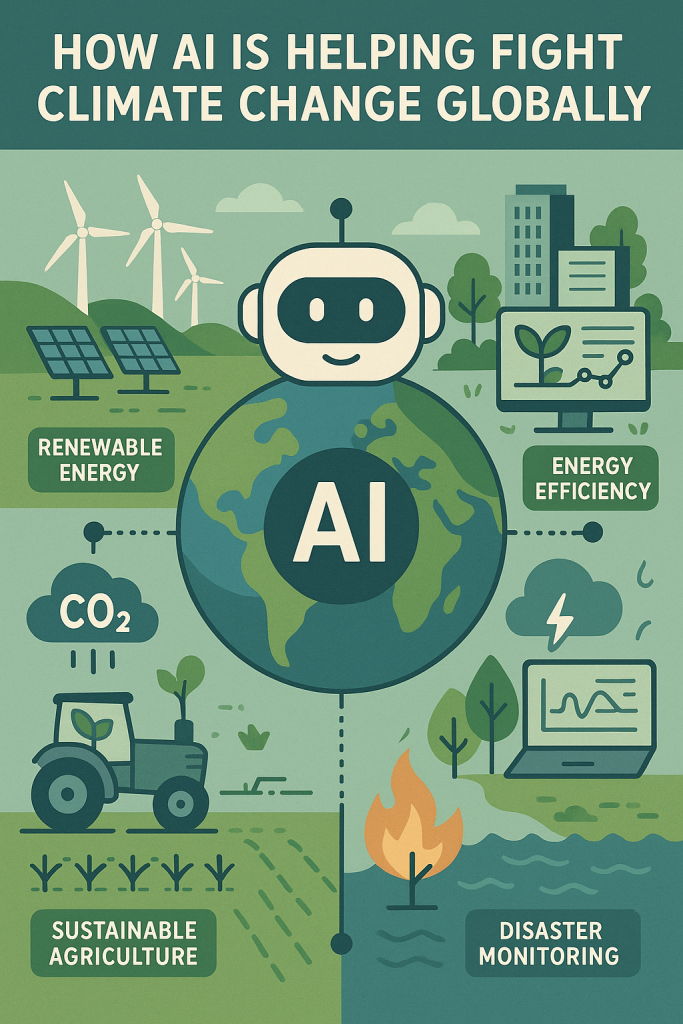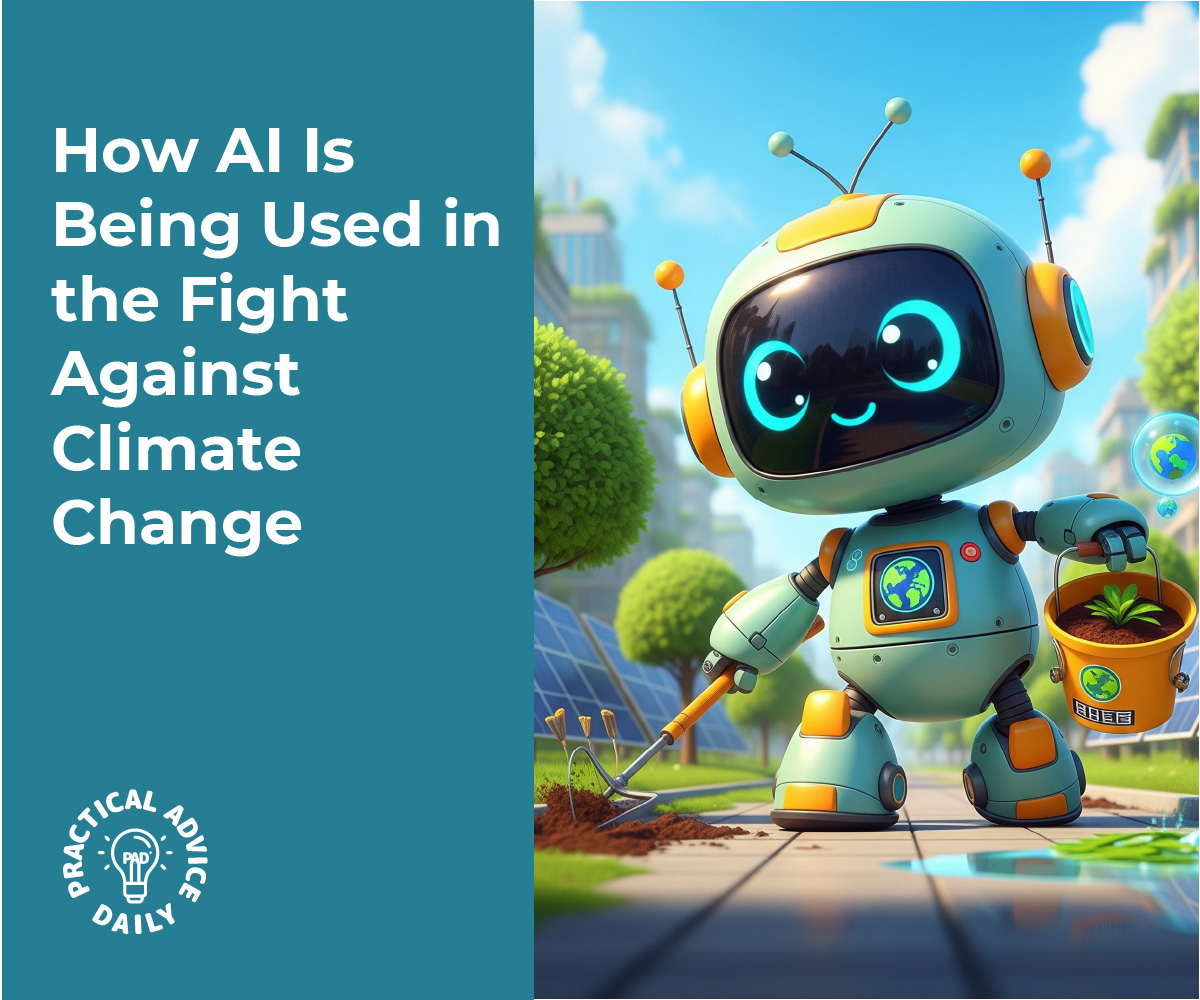Climate change is a big challenge, but new tools are helping us face it. One of the most powerful is artificial intelligence, or AI. In simple terms, AI is smart computer software that learns from data to solve problems. It can help scientists, governments, and even regular people take better care of our planet.
In this article, we’ll look at three key ways AI is being used in the fight against climate change:
- Predicting climate and weather patterns
- Improving how we use energy
- Watching over our environment and natural resources
Don’t worry if you’re not tech-savvy—this guide is beginner-friendly and full of real examples from around the world.
Table of Contents
Key Takeaways
- AI improves climate predictions by analyzing large amounts of data quickly, helping communities prepare for floods, heatwaves, and storms.
- It increases energy efficiency, especially in large systems like power grids and data centers, which reduces waste and lowers emissions.
- AI monitors the environment in real time, alerting authorities to deforestation, pollution, and other threats so action can be taken quickly.
- Real-world examples include Google’s flood alerts in Asia, smart wind farms in Europe, and rainforest monitoring in South America.
1. Predicting Climate and Weather with AI
AI helps scientists understand what’s happening with our climate—and what might happen next. This includes long-term climate models and short-term weather forecasts.
Example: AI for Flood Forecasting
In countries like India and Bangladesh, flooding is a major threat. Google has developed an AI system that uses weather data, river levels, and terrain maps to predict floods. It can warn people up to 7 days in advance, giving families time to prepare. As of now, it reaches over 460 million people in 80 countries. This early warning system has saved lives by giving people time to move to safer areas.
Example: Better Rain Predictions
In the UK and other parts of Europe, AI is improving short-term weather forecasts. Google’s DeepMind developed an AI that predicts rainfall more accurately than some traditional methods. These kinds of tools help local governments and emergency services plan for storms and floods with greater confidence.

2. Saving Energy with AI
Energy is a major part of climate change. Burning fossil fuels to create electricity releases greenhouse gases. That’s why using energy more efficiently is one of the easiest ways to cut emissions—and AI is great at that.
Example: Smarter Data Centers
Big tech companies like Google run massive data centers to power websites, videos, and cloud storage. These centers use a lot of electricity, especially for cooling the machines. Google’s AI reduced cooling energy use by 40% by predicting when machines would get hot and adjusting the cooling system accordingly. That’s a big win for both the planet and the company’s power bill.
Example: Managing Power Grids
AI is also helping to balance electricity supply and demand. Wind and solar power are great, but they depend on the weather. AI can forecast when the sun will shine or the wind will blow and adjust power use accordingly. This keeps the lights on even when the weather changes.
In the U.S. and Europe, AI is being used to improve how electricity grids operate. It can even detect potential problems—like tree branches near power lines—before outages happen. That makes the grid not only greener, but also more reliable.
Example: Efficient Buildings
AI isn’t just for big companies. Smart thermostats use AI to learn your routine and adjust heating and cooling automatically. Some office buildings use AI to manage lighting and temperature, reducing energy waste without anyone even noticing.
3. Monitoring the Environment
Another way AI helps is by watching over nature. It can monitor forests, oceans, and cities to spot changes—like illegal logging or air pollution—and send alerts so we can act fast.
Example: Listening to Rainforests
In places like the Amazon rainforest, illegal logging is a serious problem. A group called Rainforest Connection uses solar-powered devices in trees that “listen” for chainsaws. When they detect the sound, they send alerts to local rangers. This system uses old smartphones and AI to recognize dangerous activity in real time. It’s already being used in over a dozen countries.
Example: Tracking Deforestation
AI is also used with satellite images to spot forest loss. In Colombia and Brazil, systems can detect new clearings within hours of trees being cut down. This helps governments and nonprofits respond quickly, stopping further destruction and protecting wildlife.
Example: Cleaner Air in Cities
Cities in India, like Chennai, use AI to monitor air quality. Sensors collect pollution data across neighborhoods. When pollution levels rise, the AI system suggests actions like planting more trees, adjusting traffic patterns, or alerting residents. In Chennai, this led to 200,000 trees being planted to help clean the air.
Final Thoughts
Artificial intelligence may seem high-tech, but it’s being used in very down-to-earth ways to help us fight climate change. From predicting floods to reducing electricity waste and protecting rainforests, AI is quietly working behind the scenes to support a healthier planet.
You don’t have to be a scientist or tech expert to appreciate its impact. These smart systems support the people making decisions—from weather forecasters and energy managers to forest rangers and city leaders.
As AI continues to improve, it will play an even bigger role in helping us live in balance with nature. And that’s good news for everyone—because when technology and people work together, we can build a better future.
